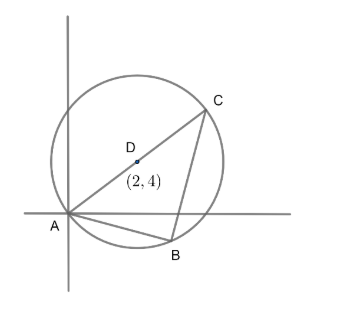
If in a triangle ABC, B is the orthocentre and if circumcentre of triangle ABC is ( 2,4) and vertex A is ( 0,0) then coordinate of vertex C is
(a) $\left( 4,2 \right)$
(b) $\left( 4,8 \right)$
(c) $\left( 8,4 \right)$
(d) $\left( 8,2 \right)$
Answer
606.9k+ views
Hint: A right angled triangle can always be inscribed inside a circle with the hypotenuse as the diameter of the circle and the midpoint of the hypotenuse of the triangle will be the circumcentre of the triangle .
Consider the figure alongside . In the question it is given that $B$ is the orthocentre. We also know that $B$ is one of the vertices of the triangle $ABC$.

So , we can conclude that $ABC$ is a right-angled triangle.
Now , we know that a right angled triangle can be inscribed in a circle with the hypotenuse as the diameter.
So , we can conclude that $AC$ is the diameter of a circle.
So , the centre of this circle will be the midpoint of the diameter.
Now, we know the midpoint of line joining the points $\left( {{x}_{1}},{{y}_{1}} \right)\text{ and }\left( {{x}_{2}},{{y}_{2}} \right)$ is given as:
$\left( \dfrac{\left( {{x}_{1}}+{{x}_{2}} \right)}{2},\dfrac{\left( {{y}_{1}}+{{y}_{2}} \right)}{2} \right)...............\left( i \right)$
Now , we will consider $\left( x,y \right)$ to be the coordinates of $C$.
We know , circumcentre of a triangle is the centre of the circle circumscribing the triangle.
So , the circumcentre $D\left( 2,4 \right)$ is the midpoint of the line joining $A\left( 0,0 \right)$ and $C\left( x,y \right)$.
Now , we will use the equation $\left( i \right)$ to find the coordinates of the vertex $C$.
So , from equation$\left( i \right)$ , we have
$2=\dfrac{x+0}{2}\Rightarrow x=4$
And $\text{ 4}=\dfrac{y+0}{2}\Rightarrow y=8$
So , the coordinates of vertex $C$ are $\left( 4,8 \right)$.
Option B - $\left( 4,8 \right)$ is correct answer
Note: The midpoint of line joining the points $\left( {{x}_{1}},{{y}_{1}} \right)\text{ and }\left( {{x}_{2}},{{y}_{2}} \right)$ is given as:
$\left( \dfrac{\left( {{x}_{1}}+{{x}_{2}} \right)}{2},\dfrac{\left( {{y}_{1}}+{{y}_{2}} \right)}{2} \right)$ and not $\left( \dfrac{\left( {{x}_{1}}-{{x}_{2}} \right)}{2},\dfrac{\left( {{y}_{1}}-{{y}_{2}} \right)}{2} \right)$ . Students often get confused between the two. Due to this confusion , they generally end up getting a wrong answer . So , such mistakes should be avoided .
Consider the figure alongside . In the question it is given that $B$ is the orthocentre. We also know that $B$ is one of the vertices of the triangle $ABC$.

So , we can conclude that $ABC$ is a right-angled triangle.
Now , we know that a right angled triangle can be inscribed in a circle with the hypotenuse as the diameter.
So , we can conclude that $AC$ is the diameter of a circle.
So , the centre of this circle will be the midpoint of the diameter.
Now, we know the midpoint of line joining the points $\left( {{x}_{1}},{{y}_{1}} \right)\text{ and }\left( {{x}_{2}},{{y}_{2}} \right)$ is given as:
$\left( \dfrac{\left( {{x}_{1}}+{{x}_{2}} \right)}{2},\dfrac{\left( {{y}_{1}}+{{y}_{2}} \right)}{2} \right)...............\left( i \right)$
Now , we will consider $\left( x,y \right)$ to be the coordinates of $C$.
We know , circumcentre of a triangle is the centre of the circle circumscribing the triangle.
So , the circumcentre $D\left( 2,4 \right)$ is the midpoint of the line joining $A\left( 0,0 \right)$ and $C\left( x,y \right)$.
Now , we will use the equation $\left( i \right)$ to find the coordinates of the vertex $C$.
So , from equation$\left( i \right)$ , we have
$2=\dfrac{x+0}{2}\Rightarrow x=4$
And $\text{ 4}=\dfrac{y+0}{2}\Rightarrow y=8$
So , the coordinates of vertex $C$ are $\left( 4,8 \right)$.
Option B - $\left( 4,8 \right)$ is correct answer
Note: The midpoint of line joining the points $\left( {{x}_{1}},{{y}_{1}} \right)\text{ and }\left( {{x}_{2}},{{y}_{2}} \right)$ is given as:
$\left( \dfrac{\left( {{x}_{1}}+{{x}_{2}} \right)}{2},\dfrac{\left( {{y}_{1}}+{{y}_{2}} \right)}{2} \right)$ and not $\left( \dfrac{\left( {{x}_{1}}-{{x}_{2}} \right)}{2},\dfrac{\left( {{y}_{1}}-{{y}_{2}} \right)}{2} \right)$ . Students often get confused between the two. Due to this confusion , they generally end up getting a wrong answer . So , such mistakes should be avoided .
Recently Updated Pages
Why are manures considered better than fertilizers class 11 biology CBSE

Find the coordinates of the midpoint of the line segment class 11 maths CBSE

Distinguish between static friction limiting friction class 11 physics CBSE

The Chairman of the constituent Assembly was A Jawaharlal class 11 social science CBSE

The first National Commission on Labour NCL submitted class 11 social science CBSE

Number of all subshell of n + l 7 is A 4 B 5 C 6 D class 11 chemistry CBSE

Trending doubts
What is meant by exothermic and endothermic reactions class 11 chemistry CBSE

10 examples of friction in our daily life

One Metric ton is equal to kg A 10000 B 1000 C 100 class 11 physics CBSE

1 Quintal is equal to a 110 kg b 10 kg c 100kg d 1000 class 11 physics CBSE

Difference Between Prokaryotic Cells and Eukaryotic Cells

What are Quantum numbers Explain the quantum number class 11 chemistry CBSE




